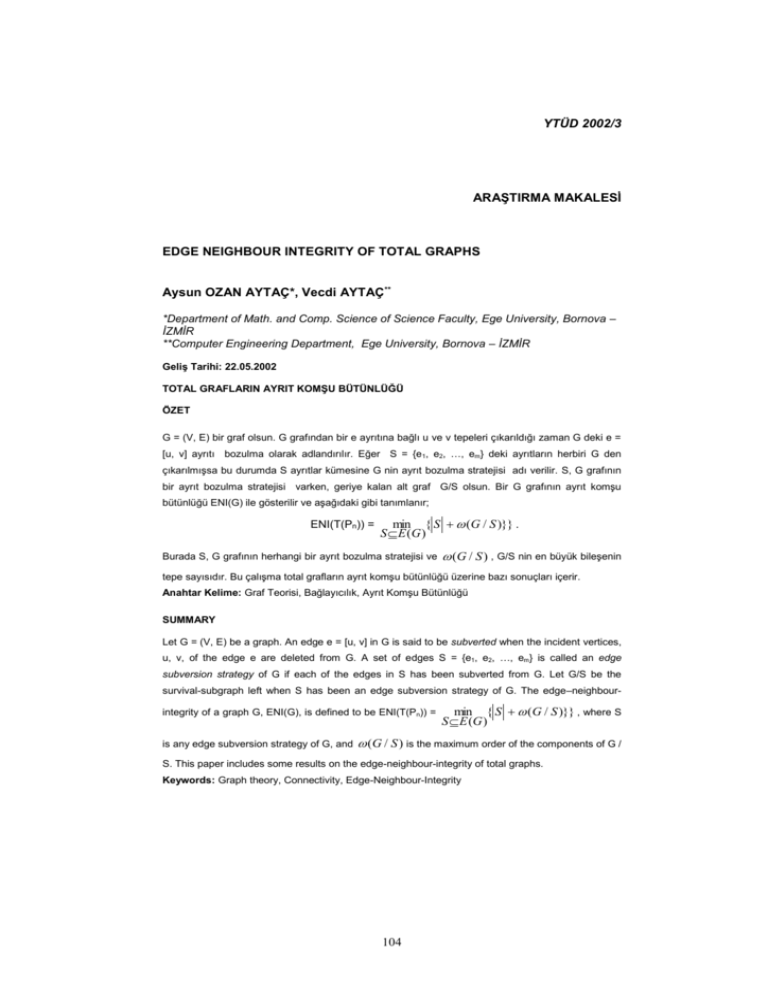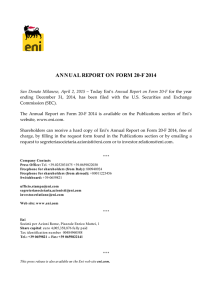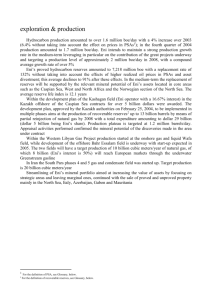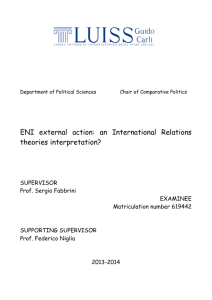4. conclusion
advertisement

YTÜD 2002/3
ARAŞTIRMA MAKALESİ
EDGE NEIGHBOUR INTEGRITY OF TOTAL GRAPHS
Aysun OZAN AYTAÇ*, Vecdi AYTAÇ**
*Department of Math. and Comp. Science of Science Faculty, Ege University, Bornova –
İZMİR
**Computer Engineering Department, Ege University, Bornova – İZMİR
Geliş Tarihi: 22.05.2002
TOTAL GRAFLARIN AYRIT KOMŞU BÜTÜNLÜĞÜ
ÖZET
G = (V, E) bir graf olsun. G grafından bir e ayrıtına bağlı u ve v tepeleri çıkarıldığı zaman G deki e =
[u, v] ayrıtı bozulma olarak adlandırılır. Eğer S = {e1, e2, …, em} deki ayrıtların herbiri G den
çıkarılmışsa bu durumda S ayrıtlar kümesine G nin ayrıt bozulma stratejisi adı verilir. S, G grafının
bir ayrıt bozulma stratejisi varken, geriye kalan alt graf G/S olsun. Bir G grafının ayrıt komşu
bütünlüğü ENI(G) ile gösterilir ve aşağıdaki gibi tanımlanır;
ENI(T(Pn)) =
min { S (G / S )}} .
S E (G )
Burada S, G grafının herhangi bir ayrıt bozulma stratejisi ve
(G / S ) , G/S nin en büyük bileşenin
tepe sayısıdır. Bu çalışma total grafların ayrıt komşu bütünlüğü üzerine bazı sonuçları içerir.
Anahtar Kelime: Graf Teorisi, Bağlayıcılık, Ayrıt Komşu Bütünlüğü
SUMMARY
Let G = (V, E) be a graph. An edge e = [u, v] in G is said to be subverted when the incident vertices,
u, v, of the edge e are deleted from G. A set of edges S = {e1, e2, …, em} is called an edge
subversion strategy of G if each of the edges in S has been subverted from G. Let G/S be the
survival-subgraph left when S has been an edge subversion strategy of G. The edge–neighbourintegrity of a graph G, ENI(G), is defined to be ENI(T(Pn)) =
is any edge subversion strategy of G, and
min { S (G / S )}} , where S
S E (G )
(G / S ) is the maximum order of the components of G /
S. This paper includes some results on the edge-neighbour-integrity of total graphs.
Keywords: Graph theory, Connectivity, Edge-Neighbour-Integrity
104
YTÜD 2002/3
1. INTRODUCTION
Barefoot, Etringer and Swart introduced integrity and edge-integrity as a measure of the
vulnerability of graphs to disruption caused by the removal of vertices or edges. [1, 2]
Goddard and Swart investigated further the bounds and properties of the integrity of
graphs.[9]
A network can be modeled by a graph whose vertices represent the stations and whose
edges represent the lines of communication. The vulnerability of the communication
network, measures the resistance of the network to disruption of operation after the
failure of certain stations or communication links. Many graph - theoretic parameters
have been used to describe the stability of the communication network, including
connectivity, integrity, and tenacity. We consider that two graphs have same connectivity;
but the orders of their largest components are not equal. Then, these two graphs must be
different with respect to stability. How can we measure that property? This idea offers
the concept of integrity that is different from connectivity.
A graph G, it is denoted by G=(V(G), E(G)), where V(G) is the set of vertices of G and
E(G) is the set of edges of G. The number of vertices and the number of edges of the
graph G are denoted by |V(G)|, |E(G)| respectively. In a graph, considering the model of
a network topology [12], efficiency decreases when some vertices or edges are
destroyed in any way. The connectivity of a graph G is the minimum number of vertices
whose removal from G results in a disconnected or trivial graph, it is denoted by k(G)
[11]. The connectivity of a graph equals the minimum number of vertices whose deletion
from the graph disconnects it into two or more components. But, for two graphs that have
same connectivity (vertex or edge) and have same number of vertices, the number of
vertices of their largest component after any disruption, can be different. Thus,
connectivity is not enough for the measure of stability. In graph theory besides
connectivity, many graph parameters have been used to describe the stability of graphs,
including connectivity, integrity, neighbor-integrity, toughness, edge-integrity, edge
neighbor-integrity and tenacity [3, 4, 5, 7, 8]. In this paper we first give the edgeneighbour-integrity as a measure of the stability of a graph. Afterwards we give some
results on the edge-neighbour-integrity of total graphs
Let G = (V, E) be a graph. An edge e = [u, v] in G is said to be subverted when the
incident vertices, u, v, of the edge e are deleted from G. A set of edges S = {e 1, e2, …,
em} is called an edge subversion strategy of G if each of the edges in S has been
subverted from G. let G/S be the survival-subgraph left when S has been an edge
subversion strategy of G. The edge-neighbour-integrity of a graph G, ENI(G), is defined
to be
min { S (G / S )}}
S E (G )
where S is any edge subversion strategy of G, and (G / S ) is the maximum order of the
ENI(T(Pn)) =
components of G / S. [4, 6] This paper includes results on the edge-neighbour-integrity of
total graphs.
x is the smallest integer greater than or equal to x. x is the greatest integer less than
or equal to x.
2. BASIC RESULTS ON EDGE NEIGHBOUR INTEGRITY
In this section we will review some of the known results.
105
YTÜD 2002/3
Theorem 2. 1 : [6] The edge neighbour integrity of
(a) the complete graph Kn is
ENI( Kn ) = n / 2 .
(b) the path Pn is
ENI( Pn ) = 2
(c) the star S1,
n–1,
ENI(S1,
n 2 – 3.
where n 3, is
n–1)
= 2.
Definition 2. 1: The vertices and edges of a graph are called its elements. Two elements
of a graph are neighbors if they are either incident or adjacent. The total graph T(G) of
the graph G = ( V(G) , E(G)), has vertex set V(G) E(G), and two vertices of T(G) are
adjacent whenever they are neighbors in G. It is easy to see that T(G) always contains
both G and the Line graph L(G) as induced sub graphs. The total graph is the largest
graph that is formed by the adjacent relations of elements of a graph [10].
.
x1
v1
x4
v4
.
.
x1
.
.
x2
x3
.
.
.
.
.
.
v1
v2
x4
v2
v4
v3
x2
v3
.
C4
x3
T(C4)
Figure 1. Formation of a total graph.
3. EDGE NEIGHBOUR INTEGRITY OF SOME TOTAL GRAPHS
In this section we give the results on edge neighbour integrity of some total graphs and
its some compounds as theorems.
Theorem 3. 1: Let Pn be an n-vertex path. Then,
ENI(T(Pn)) = 2
106
2n 1 – 3.
YTÜD 2002/3
Proof: The number of vertices of the total graph T(P n) is 2n–1. Let V(T(Pn)) = {v1, v2, ...,
v2n-1} and S be any subset of E(T(Pn)). The subversion of an edge e = [vi, vi+1] from T(Pn)
is the removal of the vertices vi and vi+1 from T(Pn), so w(T(Pn ) – S)
2n 1 2 S
S 1
.
Let | S | = m,
ENI(T(Pn)) =
Then, the function is f(m)=m+
1 2n ,
and m = –1 +
min { S ((T ( Pn )) / S )}}
S E (T ( Pn ))
2n 1 2m
m 2 4m 2n
, for m>0. From f '(m)=
=0
m 1
(m 1) 2
and the minimum value of f(m) is f (m) = –3 + 2
Consequently, ENI(T(Pn)) = 2
This completes the proof.
1 2n .
1 2n – 3.
Theorem 3. 2 : Let Cn be cycle of n vertices. Then,
ENI(T(Cn)) = 2 2n – 2.
Proof: The number of vertices of the total graph T(Cn) is 2n. In this case function f(m) is
f(m) = m +
f (m) = 2
2n 2m
. Similar to proof of Theorem 3.1, the minimum value of f (m) is
m
2n – 2 and ENI(T(Cn)) = 2 2n – 2.
Theorem 3. 3: Let S1, n be a star of n vertices. Then,
ENI(T(S1, n)) >
4n 2 – 1, for n 10 .
Proof: The number of vertices of the total graph T(S1, n) is 2n+1. In this case function f(m)
is f(m) = m +
2n 1 2m
. Similarly to proof of Theorem 3.1, the minimum value of f
2m
4n 2 – 1 and ENI(T(S1, n)) > 4n 2 – 1, for n 10. For n<10s
(m) is f (m) =
given the following table:
Table 1. ENI(T(S1, n)), for n<10
n
3
4
5
6
7
8
9
ENI
3
4
4
5
5
5
6
Definition 3. 1: The (Cartesian) product G1 x G2 of graphs G1 and G2 has V(G1) x V(G2)
as its vertex set and (u1, u2) is adjacent to (v1, v2) if either u1 = v1 and u2 is adjacent to v2
or u2 = v2 and u1 is adjacent to v1.
Next we give the edge neighbour integrity of total graphs of K2 x Pn and K2 x Cn.
107
YTÜD 2002/3
Theorem 3. 4: Let K2 x Pn be with 2n vertices mesh. Then,
ENI(T(K2 x Pn))
6(5n 2) – 3.
Proof: The number of vertices of the total graph T(K 2 x Pn) is 5n – 2. In this case function
f(m) is f(m) = m +
of f (m) is f (m) =
5n 2 2m
. Similarly to proof of Theorem 3.1, the minimum value
2m
3
6(5n 2) – 3 and ENI(T( K2 x Pn )) 6(5n 2) – 3, for n
5. The following table is given for n<5:
Table 2. ENI(T( K2 x Pn )), for n<5
N
3
4
ENI
6
7
Theorem 3. 5: Let K2 x Cn be with 2n vertices torus. Then,
ENI(T( K2 x Cn ))
6(5n 4) – 1.
Proof: The number of vertices of the total graph T(K2 x Cn) is 5n.In this case function f(m)
5n 2 m
. Similar to proof of Theorem 3.1, the minimum value of
2m 4
3
6(5n 4) – 1 and ENI(T( K2 x Cn )) 6(5n 4) – 1.
is f(m) = m +
is f (m)
f (m)
4. CONCLUSION
Suppose that we want to design a new network with 40 vertices. How do we must design
it, according to edge neighbour-integrity and total graph structure?
Table 3. For 40 vertices, some of alternative design.
N=40
P40
C40
S1, 39
K2 P20
K2 C20
The total of the graph
T(P40) V(T(P40))=79
T(C40)V(T(C40))=80
T(S1, 39)V(T(S1, 39))=79
T(K2 P20)V(T(K2 P20)=80
T(K2 C20)V(T(K2 C20))=82
ENI
15
16
21
30
31
By definition of the total graph, the ENI(T(G)) of any graph G which has the most edge is
the biggest among the considering structure of the graph with 40 vertices. We must
108
YTÜD 2002/3
design the new networks as T(K2 C20), because its edge neighbour-integrity is greater
than the other designs. This construction is more stable all the others.
REFERENCES
[1] Barefoot, C.A.- Entringer, R. and Swart, H.: Vulnerability in Graphs-A Comparative
Survey, J. Combin. Math. Combin. Comp., 1, 1987, pp. 13-22.
[2] Barefoot, C.A.- Entringer, R. and Swart, H.: Integrity of Trees and Powers of cycles,
Congr. Numer., 58, 1987, pp. 103-114.
[3] Chvatal, V.: Tough Graphs and Hamiltonian Circuits, Discrete Math.5,pp. 2151973.
218,
[4] Cozzens, M.B. - Wu, S. Y.: Edge Neighbor-Integrity of Trees, Australian J. Of
Combinatorics, 10, 1994, pp. 163-174.
[5] Cozzens, M.B. - Wu, S. Y.: Vertex Neighbor-Integrity of Trees, Ars. Combinatoria, 43,
1996, pp. 169-180.
[6] Cozzens, M.B. - Wu, S. Y.: Bounds of Edge-Neighbor-Integrity of Graphs,
Australasian Journal of Combinatorics, 15, 1997, pp. 71-80.
[7] Dündar, P.– Ozan, A.: Stability Measures of Torus And Mesh Graphs, Int. J.of
Mathematical Algorithms, submitted, 2002.
[8] Dündar, P.- Ozan, A.: The Neighbour-integrity of Sequential Joined Graphs, Intern. J.
Computer. Math, 2000, vol 74, pp. 45-52.
[9] Goddard, W. - Swart, H. C. : Integrity in Graphs: Bounds and Basics, J. Combin.
Math. Combin. Comput. 7, 1990, pp. 139-151.
[10] Harary , F.: Graph Theory , Addison-Wesley Pub. California, 1971.
[11] Lesniak, L. – Chartrand, G.: Graphs and Digraphs, California Wadsworth & Brooks,
1986.
[12] Kumar, V. -Grama, A.- Gupta, A.- Karpis, G.: Introduction To Parallel Computing,
California, The Benjamin Cummings Pub., 1995.
109














